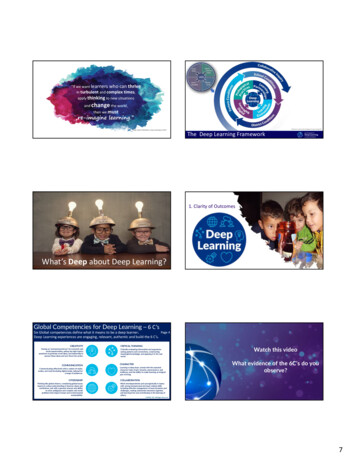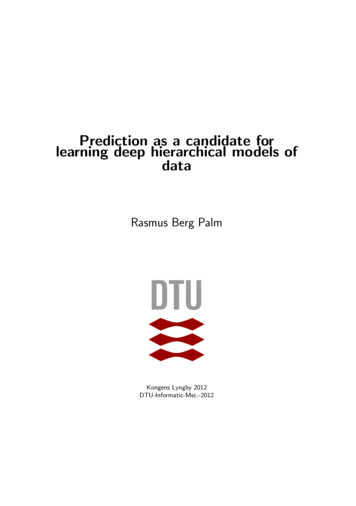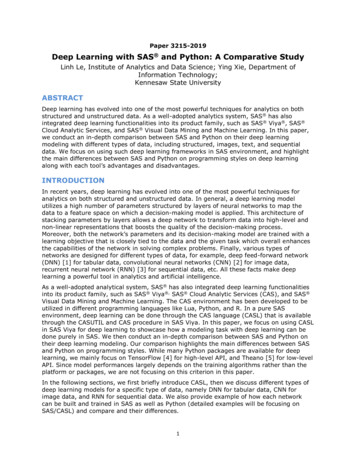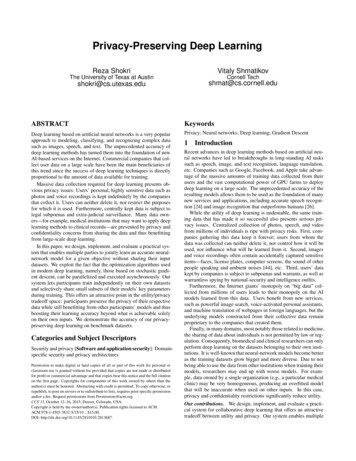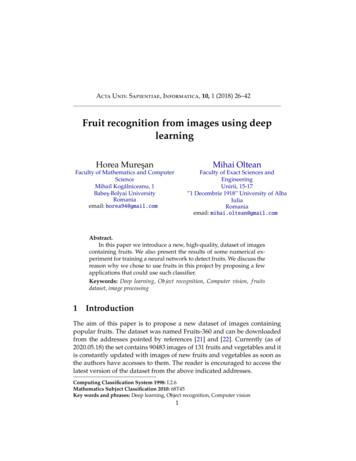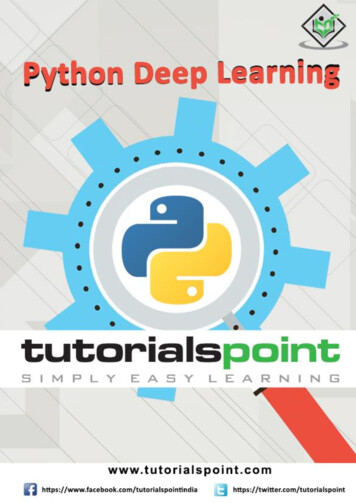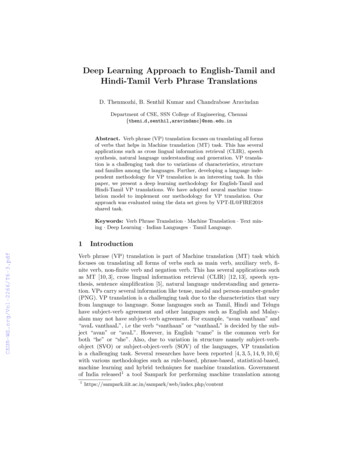
Transcription
Deep Learning Approach to English-Tamil andHindi-Tamil Verb Phrase TranslationsD. Thenmozhi, B. Senthil Kumar and Chandrabose AravindanDepartment of CSE, SSN College of Engineering, Chennai{theni d,senthil,aravindanc}@ssn.edu.inAbstract. Verb phrase (VP) translation focuses on translating all formsof verbs that helps in Machine translation (MT) task. This has severalapplications such as cross lingual information retrieval (CLIR), speechsynthesis, natural language understanding and generation. VP translation is a challenging task due to variations of characteristics, structureand families among the languages. Further, developing a language independent methodology for VP translation is an interesting task. In thispaper, we present a deep learning methodology for English-Tamil andHindi-Tamil VP translations. We have adopted neural machine translation model to implement our methodology for VP translation. Ourapproach was evaluated using the data set given by VPT-IL@FIRE2018shared task.Keywords: Verb Phrase Translation · Machine Translation · Text mining · Deep Learning · Indian Languages · Tamil Language.1IntroductionVerb phrase (VP) translation is part of Machine translation (MT) task whichfocuses on translating all forms of verbs such as main verb, auxiliary verb, finite verb, non-finite verb and negation verb. This has several applications suchas MT [10, 3], cross lingual information retrieval (CLIR) [12, 13], speech synthesis, sentence simplification [5], natural language understanding and generation. VPs carry several information like tense, modal and person-number-gender(PNG). VP translation is a challenging task due to the characteristics that varyfrom language to language. Some languages such as Tamil, Hindi and Teluguhave subject-verb agreement and other languages such as English and Malayalam may not have subject-verb agreement. For example, “avan vanthaan” and“avaL vanthaaL”, i.e the verb “vanthaan” or “vanthaaL” is decided by the subject “avan” or “avaL”. However, in English “came” is the common verb forboth “he” or “she”. Also, due to variation in structure namely subject-verbobject (SVO) or subject-object-verb (SOV) of the languages, VP translationis a challenging task. Several researches have been reported [4, 3, 5, 14, 9, 10, 6]with various methodologies such as rule-based, phrase-based, statistical-based,machine learning and hybrid techniques for machine translation. Governmentof India released1 a tool Sampark for performing machine translation .php/content
2D. Thenmozhi et. al.Indian languages. Recently, Microsoft claims that developing deep neural network for Indian language translations brings more accuracy2 . Further, developingmethodology that performs VP translation between different language familiessuch as Indo-Aryan, Indo-European and Dravidian is a difficult task. The sharedtask VPT-IL@FIRE2018 focuses on VP translations between different languagefamilies. The goal of VPT-IL@FIRE2018 task is to research and develop techniques to English-Tamil and Hindi-Tamil VP translations. VPT-IL@FIRE2018is a shared Task on Verb Phrase Translation in English and Indian languagescollocated with Forum for Information Retrieval Evaluation (FIRE-2018). Thispaper focuses on developing a methodology which does not require any linguistic knowledge that can translate VPs between any two languages of differentfamilies.2Proposed MethodologyA Sequence to Sequence (Seq2Seq) [11, 2] deep neural network is used in ourapproach for English-Tamil and Hindi-Tamil verb phrase translations. The stepsused in our approach are given below.– Extract English / Hindi VP sequences and Tamil VP input sequences fromthe given training data (English / Hindi and Tamil sentences) using the VPmapping information.– Split the English / Hindi VP sequences and Tamil VP input sequences intotraining and development sets– Determine vocabulary from both English / Hindi VP input sequences andTamil VP input sequences.– Build a deep neural network using Seq2Seq model with the layers namely embedding layer, encoding-decoding layer and projection layer with attentionwrapper.– Extract English / Hindi VP sequences from English / Hindi sentences of thetest data– Predict the Tamil VP output sequences for the English / Hindi VP sequences.– Construct the Tamil VP output sequences into required output format.The steps are detailed below.2.1Extraction of VP SequencesThe given text consists of parallel sentences in English and Tamil languagesfor Task 1 and parallel sentences in Hindi and Tamil for Task 2. The inputsentences are tagged with sentence id and language information. Figure 1 showsthe example parallel sentences for English and Tamil and Figure 2 shows theparallel sentences for Hindi and ks-announcement/
DL approach to EN-TA and HI-TA VP Translations3Fig. 1. English and Tamil Parallel Sentences.Fig. 2. Hindi and Tamil Parallel Sentences.We have prepared the data in such a way that Seq2Seq deep learning algorithm may be applied. The English / Hindi VP input sequences and TamilVP input sequences are constructed separately by extracting verb phrases fromEnglish / Hindi and Tamil sentences based on the VP mapping which consistsof information namely sentence id, source language, target language, VP id,VP source information and VP target information. The VP source and targetinformation consists of VP start position and length fields. The format of VPmapping is given in Figures 3 and 4.Fig. 3. English-Tamil VP Mapping.The VP start position and length fields are used to extract the verb phrasespresent in sentences. For the above examples, the verb phrases are extracted asshown in Figures 5 and 6
4D. Thenmozhi et. al.Fig. 4. Hindi-Tamil VP Mapping.Fig. 5. English and Tamil Verb Phrase.2.2Model Building using Seq2Seq ModelWe have adopted Neural Machine Translation (NMT) framework [8, 7] based onSeq2Seq model for VP translation task. Figure 7 shows the different layers usedin deep neural network to build model for VP translation.The verb phrases that are extracted using the previous step are given tothe deep neural network. Sequence of layers namely embedding layer, encoderdecoder layer and projection layer are employed in the neural network to obtainTamil VPs. We have determined the vocabulary for both English / Hindi VPinput sequences (source input sequences) and Tamil VP input sequences (targetinput sequences). The source input sequences and the target input sequencesare splitted into training sets and development sets. The English / Hindi VPinput sequences with m words x1 , x2 , .xm and Tamil VP input sequences withn words y1 , y2 , .yn where m need not be equal to n are given to the embeddinglayer. The embedding layer learns weight vectors from the source input sequencesand target input sequence based on their vocabulary. These vectors are givento multi-layer LSTM that performs encoding and decoding operations. We haveused an attention mechanism [1, 7] to obtain an overall word alignment betweenthe source and target sequences. The main idea of attention mechanism is to havedirect connection between the source and target by paying attention to relevantsource words (English / Hindi) as we translate into Tamil phrase. projectionFig. 6. Hindi and Tamil Verb Phrases.
DL approach to EN-TA and HI-TA VP Translations5Fig. 7. System Architecture for Verb Phrase Translation.layer that utilizes Softmax activation function is used to obtain the Tamil VPoutput sequences.2.3PredictionThe model that is built by using deep neural network is used to predict Tamil VPoutput sequences for the given English / Hindi verb phrases of test data. For this,we have extracted English / Hindi verb phrases from English / Hindi sentencesof test data using the VP mapping information. The sample sentences given forEnglish / Hindi languages and the corresponding VP mapping information fortest data are shown in Figures 8 and 9.Fig. 8. English and Hindi Sentences.The Tamil VP output sequences are obtained for the extracted English /Hindi VP input sequences using the deep neural model based on sequence mapping. We have constructed the Tamil VP output sequences for the test data intothe required output format which is shown in Figure 10.
6D. Thenmozhi et. al.Fig. 9. VP Mapping for Test Data.Fig. 10. VP Translation Output.3ImplementationWe have used Python to extract VPs from English, Hindi and Tamil sentences.We have used TensorFlow for implementing the deep neural network. We haveused the data set provided by VPTIL@FIRE2018 to evaluate our methodology.The data set used to evaluate the verb phrase translation task consists of atraining set and test set for separately for English-Tamil and Hindi-Tamil. Thetraining data contains parallel sentences in English and Tamil languages forTask 1 and parallel sentences in Hindi and Tamil languages for Task 2. VPmapping information is provided separately for both the tasks which consistsof the attributes namely sentence id, source language, target language, VP id,VP source information and VP target information. The VP source and targetinformation values have two parts namely VP start position and length of theVP. The details of the VPTIL@FIRE2018 data are given in Table 1.Table 1. Data Set for VPTIL TaskTasksTrainingTestingNo. of Sentences No. of VPs No. of Sentences No. of 710001384We have extracted the textual part of the input sentences by removing the Sent tags. For example, we have extracted the text “ENG:The General of the
DL approach to EN-TA and HI-TA VP Translations7Chozha forces in Lanka at that time was Kodumbalur Poodhi Vikrama Kesari .”from the input Sent Id 1 lang ’en’ ENG:The General of the Chozha forcesin Lanka at that time was Kodumbalur Poodhi Vikrama Kesari . /Sent byremoving Sent Id 1 lang ’en’ and /Sent . We have used the VP startposition and length fields of VP source and target information from VP mappingto extract the verb phrases present in source and target languages. For example, the text that starts at position 59 for 3 character length is extracted fromEnglish with sentId 1 using the VP mapping information vpInfo sentId ’1’ srcLang ’en’ tgtLang ’ta’ vpId ’1’ vp src info ’59,3’ vp tgt info ’92,9’ . Theobtained English VP input sequence with respect to vpId 1 is “was”. For somesentences, the tokens for the verb phrase may not be continuous. For example, the VP mapping vpInfo sentId ’13’ srcLang ’en’ tgtLang ’ta’ vpId ’20’vp src info ’41,7;56,14’ vp tgt info ’59,15’ conveys that the English VP sequence is present in two postions 41 and 56 with the length 7 and 14 respectivelyin the sentence Sent Id 13 lang ’en’ ENG:He opened his eyes and found thecat rubbing itself affectionately against him . /Sent . We have extracted theVPs in two positions as “rubbing” and “affectionately”, and concatenated themas a single VP ”rubbing affectionately” with respect to vpId 13 for English.The extracted English / Hindi VP input sequences and Tamil VP inputsequences are splitted into train set and development set to feed into the deepneural network. The details of the splits are given in Table 2.Table 2. Number of Sequences for Model BuildingTasksTraining DevelopmentEnglish-Tamil 1700575Hindi-Tamil1817800We have used TensorFlow code based on tutorial code released by NeuralMachine Translation 3 [7] that was developed based on Sequence-to-Sequence(Seq2Seq) models [11, 1, 8] to implement our deep learning approach for VPtranslations. We have implemented the Seq2Seq model using several parameters.The details are given below.–––––––Recurrent unit: LSTMDirection: Bi-directionalNo. of layers: 8Dropout: 0.2Batch size: 128Attention: BahdanauNumber of training steps: 50000We have extracted the English / Hindi VP input sequences from the testdata similar to training data. The Tamil VP output sequences are inferred with3https://github.com/tensorflow/nmt
8D. Thenmozhi et. al.respect to the English / Hindi VP input sequences for the given test instancesusing our bi-LSTM model. Finally, we have converted the obtained Tamil VPoutput sequences into the required output format for the submission by addingthe attribute as “translatedVP”. The output format is shown in Figure 10.4ResultsWe have evaluated our models for English-Tamil and Hindi-Tamil VP translations using the data set provided by VPT-IL@FIRE2018 shared task. Table 3shows the precision and recall values we have obtained for the test data usingour models.Table 3. Test Data PerformanceTasksPrecision(%) .21It is observed from Table 3 that we have not obtained significant improvementin the performance. This is due to the size of the data set.5ConclusionsWe have presented a deep learning approach based on Seq2Seq model for EnglishTamil and Hindi-Tamil VP translations. We have used the data set provided byVPT-IL@FIRE2018 shared task. We have extracted English / Hindi VP sequences (source sequences) and Tamil VP input sequences (target sequences)from the given training data namely English / Hindi sentences and Tamil sentences respectively using verb phrase start position and length fields of sourceand target information present in the VP mapping file. These source and targetinput sequences are given to the deep neural network. The network consists of anembedding layer, encoding-decoding layer with 8-layer LSTM and a projectionlayer to translate the verb phrases from English / Hindi to Tamil. The embedding layer converts the source VP sequences and target VP input sequences intotheir vector representations based on the vocabulary of the source and targetlanguages respectively. We have adopted Neural Machine Translation model forthis task. The weight vectors learnt from embedding layer for training data aregiven to 8-layer LSTM where encoding and decoding are performed. We haveused Bahdanau attention wrapper to obtain an overall word alignment betweenthe source and target input sequences. Projection layer that uses Softmax activation function is used to obtain the Tamil verb phrase output sequences. Thismodel is used to infer the Tamil VP output sequences for English / Hindi verbphrases of test data. Finally, the translated Tamil VP output sequences are converted to the required output format for submission. We have obtained precision
DL approach to EN-TA and HI-TA VP Translations9and recall values as 10.06% and 16.53% respectively for English - Tamil verbtranslations. For Hindi - Tamil verb translations, we have obtained precisionand recall values as 16.84% and 18.21% respectively. The performance may beimproved further with increased data set by incorporating more hidden layers,different attentions and increasing training steps.References1. Bahdanau, D., Cho, K., Bengio, Y.: Neural machine translation by jointly learningto align and translate. arXiv preprint arXiv:1409.0473 (2014)2. Cho, K., Van Merriënboer, B., Gulcehre, C., Bahdanau, D., Bougares, F., Schwenk,H., Bengio, Y.: Learning phrase representations using rnn encoder-decoder forstatistical machine translation. arXiv preprint arXiv:1406.1078 (2014)3. Devi, S.L., Pralayankar, P., Kavitha, V., Menaka, S.: Translation of hindi se totamil in a mt system. In: Information Systems for Indian Languages, pp. 246–249.Springer (2011)4. Devi, S.L., Pralayankar, P., Menaka, S., Bakiyavathi, T., Ram, R.V.S., Kavitha, V.:Verb transfer in a tamil to hindi machine translation system. In: Asian LanguageProcessing (IALP), 2010 International Conference on. pp. 261–264. IEEE (2010)5. Hasler, E., de Gispert, A., Stahlberg, F., Waite, A., Byrne, B.: Source sentencesimplification for statistical machine translation. Computer Speech & Language45, 221–235 (2017)6. Jadoon Khan, N., Anwar, W., Durrani, N.: Machine translation approaches andsurvey for indian languages. arXiv preprint arXiv:1701.04290 (2017)7. Luong, M., Brevdo, E., Zhao, R.: Neural machine translation (seq2seq) tutorial.https://github.com/tensorflow/nmt (2017)8. Luong, M.T., Pham, H., Manning, C.D.: Effective approaches to attention-basedneural machine translation. arXiv preprint arXiv:1508.04025 (2015)9. Macketanz, V., Avramidis, E., Burchardt, A., Helcl, J., Srivastava, A.: Machinetranslation: Phrase-based, rule-based and neural approaches with linguistic evaluation. Cybernetics and Information Technologies 17(2), 28–43 (2017)10. Sridhar, R., Sethuraman, P., Krishnakumar, K.: English to tamil machine translation system using universal networking language. Sādhanā 41(6), 607–620 (2016)11. Sutskever, I., Vinyals, O., Le, Q.V.: Sequence to sequence learning with neuralnetworks. In: Advances in neural information processing systems. pp. 3104–3112(2014)12. Thenmozhi, D., Aravindan, C.: Tamil-english cross lingual information retrievalsystem for agriculture society. In: Tamil Internet Conference (TIC2009), 9th International Conference on. pp. 173–178 (2009)13. Thenmozhi, D., Aravindan, C.: Ontology-based tamil–english cross-lingual information retrieval system. Sādhanā 43(10), 157:1–14 (2018)14. Wang, X., Tu, Z., Xiong, D., Zhang, M.: Translating phrases in neural machinetranslation. arXiv preprint arXiv:1708.01980 (2017)
paper, we present a deep learning methodology for English-Tamil and Hindi-Tamil VP translations. We have adopted neural machine trans-lation model to implement our methodology for VP translation. Our approach was evaluated using the data set given by VPT-IL@FIRE2018 shared task. Keywords: Verb Phrase Translation Machine Translation Text min-
